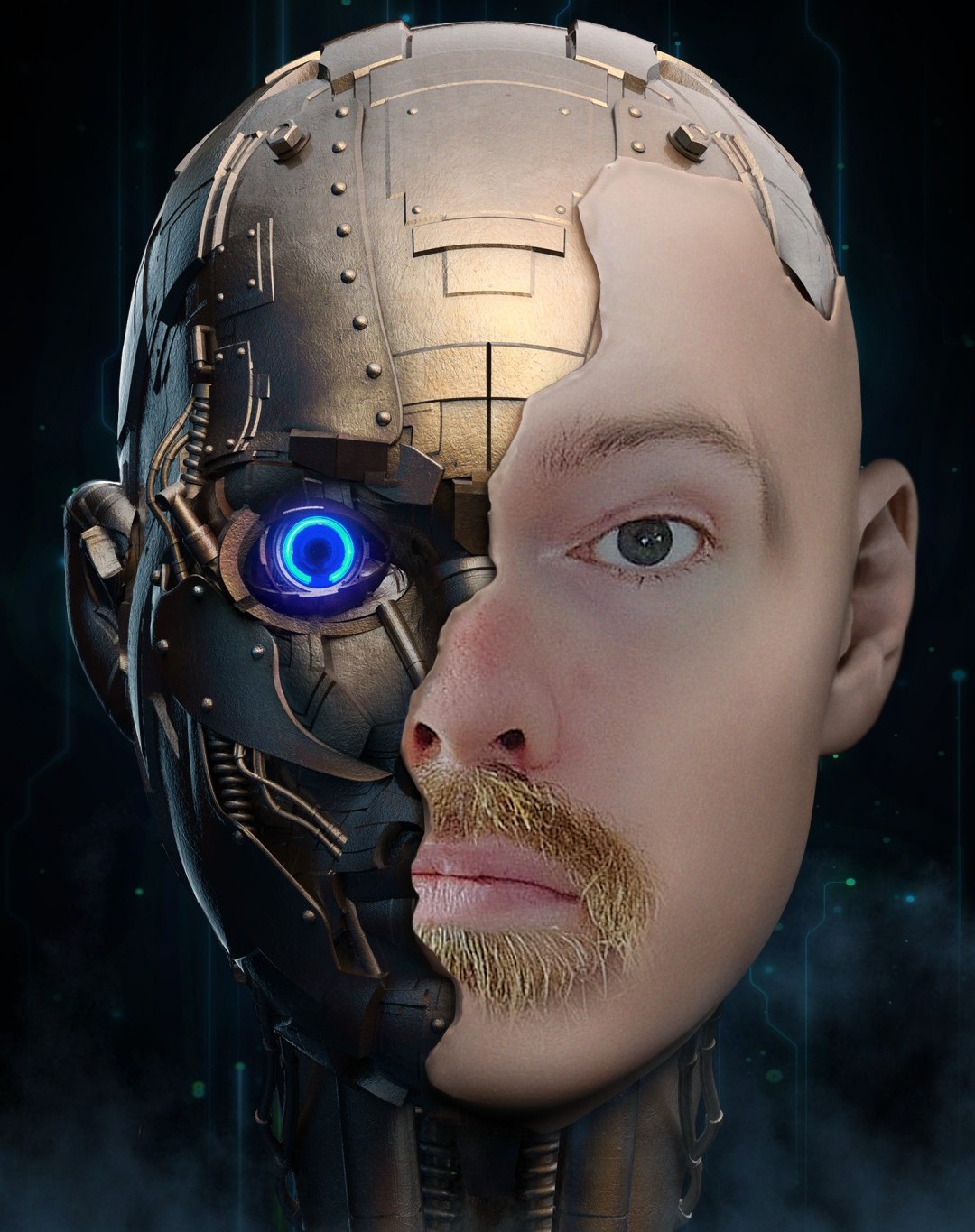Table of Contents
Can a simple chip embedded into a human brain even qualify as a cyborg? When I think of cyborgs, the first name that comes to mind is Neil Harbisson; however, I don’t personally consider him a cyborg. Just as I don’t consider those with biochips and cybernetic implants to be cyborgs, either. This is the same world that seemingly hands out trophies just for showing up though.
"First Cyborg" — Neil Harbisson
Neil Harbisson’s case, however, challenges that notion. Harbisson is a Catalan artist and composer born with achromatopsia, a condition that makes him completely colorblind. To compensate, he had an antenna implanted into the back of his skull that converts colors into sound frequencies—allowing him to perceive colors through auditory signals. This technological extension is both a sensory augmentation and a form of personal expression, challenging traditional notions of human perception and identity.
In my opinion, a cyborg is half machine and half man; think Star Trek, or the best of both worlds. Neil Harbisson has a piece of customized technology (an antenna) inserted into his skull. I suppose my definition doesn’t matter, as the world accepts him as he is. His antenna was implanted as part of his quest to expand his sensory experience.
The antenna provides him with an augmented perception of color that he couldn’t experience otherwise, opening new artistic and perceptual horizons. His condition, achromatopsia, is a rare disorder where the cones in his eyes—responsible for color vision—are non-functional. By turning colors into sound, he expands his sensory world and challenges our notions of what it means to perceive reality.
Harbisson’s life and work serve as a powerful example of how cybernetic enhancements can redefine what it means to be human, pushing the boundaries of identity, perception, and art. His case illustrates that the line between human and machine is increasingly blurred, and that such technological integrations can be both functional and deeply personal.
Perhaps semantics aren't even the aspect I should be focusing on. Musk believes that his brain chip will allow people with spinal cord injuries to take back control of their lives and limbs using his Neuralink technology. It is a noble goal, but Musk is a billionaire, and he does a lot of shady deals with government types.
Introduction To Brain-Computer-Interface
Neuralink, an implantable brain-computer interface[1] (BCI for short), isn't a computer chip in the classic sense; instead, it's been described as a series of probes composed mostly of polyimide—an incredibly biocompatible material—along with a thin gold or platinum conductor.
It has wires with electrodes attached that allow it to detect and locate electrical signals in the brain. These probes are inserted into a human brain by a specialized surgical robot. As with everything Musk does, it’s a complicated but brilliant process.
What makes BCIs so fascinating—and simultaneously terrifying—is their potential to revolutionize how we interact with technology. Despite the risks, BCIs like Neuralink offer incredible potential. For people with paralysis or neurodegenerative diseases, these devices could restore lost functions—allowing them to speak, move prosthetic limbs, or even regain independence.
Early experiments with animals showed neural signals can be decoded and translated into commands with impressive accuracy. If successful, this technology could revolutionize medicine and dramatically improve countless lives.
Furthermore, BCIs could pave the way for new forms of human-computer interaction, making control more seamless than ever. Imagine operating your devices just by thinking, or sharing sensory experiences directly with others. The benefits are profound, especially for enhancing quality of life and expanding human capabilities.
If you aren’t familiar with polyimide, check the link below for an introduction:
https://material-properties.or...
Security Concerns
However, with all this promise come serious security concerns. The very same technology that could help millions also opens vulnerabilities—malicious hackers could potentially hijack neural signals, manipulate thoughts, or even control actions without consent. The risk of "brain jacking"—unauthorized takeover of someone’s neural activity—is not just science fiction.
Cybersecurity experts actively discuss these vulnerabilities, and research shows that as BCI technology advances, so do the methods for exploiting it. The potential for hacking, data theft, or even mind control makes this a moral and security minefield.
Almost everything in this life that began as noble eventually ends up being evil—whether it’s nuclear energy, genetic modification, or even the internet. Today, these chips and probes could cure neurological disorders and paralysis, while tomorrow they could be used to give the government full control over every action you perform.
And this leads to some even scarier possibilities. Say, at this moment, you are a proud Democrat, Independent, or Republican—but two seconds from now, you are the opposite because someone, somewhere, flipped a switch and you are whatever they want you to be. If it were me, I would be carefully considering the potential pitfalls and ramifications of such technology, but I’m far too cautious. This technology is rarely used for what they claim it will be, and all I’m saying is that in the wrong hands, it’s dangerous.
Historical Examples Of Misuse
History is littered with examples—think of the misuse of the Tuskegee syphilis study, the CIA’s MKUltra experiments, or even the NSA’s surveillance programs. Noble intentions often serve as the cover story for darker motives, and neural tech will likely follow the same path if left unchecked. Some might argue that these were government programs and Musk’s is private, and therefore I’m only being alarmist. But I am being practical and realistic.
The Tuskegee syphilis study[2] involved deliberately withholding treatment from Black men infected with syphilis, simply to observe the natural progression of the disease. It lasted for decades and resulted in unnecessary suffering and death, revealing a stark disregard for human life and ethics.
MKUltra[3], the CIA’s secret mind-control program, aimed to develop techniques for interrogation and manipulation, often using drugs like LSD on unwitting subjects—causing lasting psychological damage.
The NSA’s surveillance programs, exposed through leaks, showed how government agencies collected vast amounts of data on millions of ordinary citizens without their knowledge or consent, eroding privacy and civil liberties.
These programs, driven by motives of control, power, and national security, left a dark legacy of exploitation, secrecy, and moral bankruptcy. Their conclusions were often disastrous—they revealed a willingness to sacrifice human rights in pursuit of questionable goals, and the abuses only came to light after decades of secrecy.
Last Reprieve?
On the other hand, I see the perspective of those with debilitating conditions. Being confined to a chair, having limited use of limbs or even none at all while only being able to think—a lot of people with these severe conditions can’t even speak physically. Putting myself in their shoes, I would be just about willing to do anything to claw back control of my own life.
I personally don’t have my own family yet, apart from stuffed animals, of course. But if I did, I would be willing to do anything to be there for them, to be part of their lives and see them into adulthood—an important milestone in everyone’s life.
In such cases, I suspect it’s more a matter of necessity rather than want. I don’t think anyone wants a stranger opening their skull and playing connect-the-dots with their brain or a robot for that matter, only someone so desperate and who has exhausted all other options would be in this boat.
Getting Brain Jacked Is Cool
Then you have the people who aren’t facing a life-or-death situation and just like the idea of having Musk’s latest tech because they’re collectors—whether that’s AI, cars, payment processors, robots, or anything else Musk has ever done—and consider it a badge of honor to be discombobulated in the name of fandom. Maybe they even think they’ll gain a personality from it, beyond being followers!
It’s no surprise so many people allegedly like the idea of being brain-jacked. There will always be those who need to be guided and led in life, and that’s the real threat: willful ignorance. In an America where nobody is who they seem to be and everything designed to help humans ends up harming them, where is the common sense?
What's The Risk
So what exactly is the risk of someone being controlled against their will through Neuralink technology? As discussed earlier, such technology (BCI's) brings potentially dangerous consequences. Who knows? Musk keeps specific details about Neuralink highly guarded, so we won’t know the full scope until he chooses to reveal it.
Apart from the obvious risk of cracking someone’s skull and playing with their neural tissue, the process of pairing a human with a polyimide-based device increases the chance of complications, infections, or worse. And once connected, who’s to say the tech can’t be hacked? Or that malicious actors won’t exploit vulnerabilities? History teaches us that every new tech, no matter how noble, can be turned into a weapon.
12 Implants So Far
Neuralink announced on September 9, 2025, that they now have 12 patients implanted with their N1 chip.
According to a report by PCMag published the next day, Musk and Neuralink have quadrupled the number of test subjects in 2025.
https://www.pcmag.com/news/12-...
With no FDA approval for Neuralink or any other brain-computer interface in the U.S., these are real human trials happening in a gray area. Just a few years ago, we were asking “what if,” and now we’re at “when.” The rapid pace of development raises urgent questions about safety, oversight, and ethics.
Final Thought
In the end, technological advancements like Neuralink stand at a crossroads of promise and peril. The tools that could restore mobility, speech, and independence to those suffering from devastating conditions could also become instruments of control, exploitation, and manipulation.
The question isn’t just what this tech can do, but what it will do when wielded by those with greed, malicious intent, or unchecked power. History repeatedly shows us that every breakthrough—be it nuclear energy or genetic engineering—carries a dark mirror image, waiting to be exploited if safeguards are not rigorously enforced.
We are living in an era where the line between human and machine blurs faster than ever. As we venture into this uncharted territory, we must ask ourselves: Are we building a future that enhances human dignity and freedom, or one that deepens our vulnerabilities and dependence?
The allure of technological progress can blind us to the costs—costs paid not just in dollars but in autonomy, privacy, and our very sense of self. If we’re not careful, the very innovations meant to elevate us could become chains that bind us tighter than ever before.
Ultimately, the choice is ours. Do we embrace the promise of merging man with machine, knowing full well every step forward may carry the seed of our own undoing? Or do we exercise caution, demanding transparency, regulation, and ethical oversight before allowing these powerful tools to reshape our brains and bodies?
The future of neural technology isn’t just a matter of science—it’s a moral battleground where human freedom, privacy, and agency hang in the balance.
Lebedev, M. A., and Nicolelis, M. A. L. (2006). “Brain–machine interfaces: past, present and future.” Trends in Neurosciences, vol. 29, no. 9, pp. 536–546. https://doi.org/10.1016/j.tins.2006.07.004
The Tuskegee Syphilis Study
CDC. “The Tuskegee Study of Untreated Syphilis.” Centers for Disease Control and Prevention, 2022.
https://www.cdc.gov/tuskegee/index.html
MKUltra Program
CIA. “MKUltra - CIA’s Mind Control Program,” declassified documents.
https://www.cia.gov/readingroom/collection/mkultra

